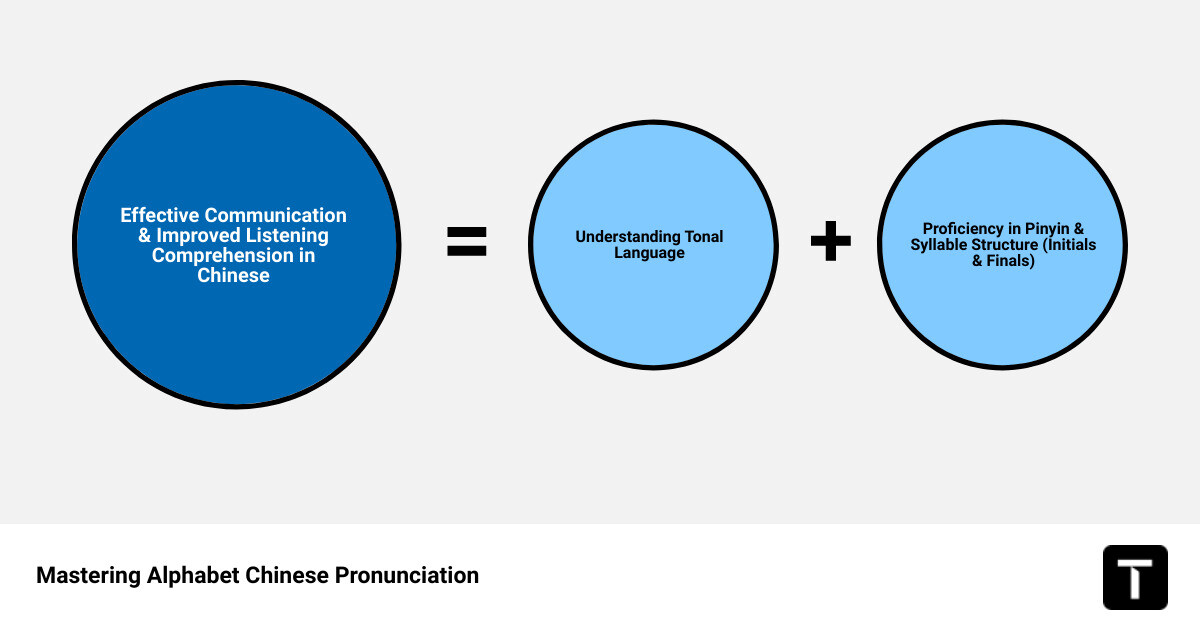Have you ever tried to communicate in a foreign language, only to be met with blank stares because of your pronunciation? If so, you're not alone. Mastering alphabet Chinese pronunciation can be a daunting task, especially when you're learning Mandarin, a language known for its tones and unique sounds. However, achieving accurate pronunciation is crucial for effective communication and can be the key to unlocking a deeper understanding of the Chinese culture.
At Traverse, we believe that learning Mandarin, including Chinese characters, is not just about memorizing words and sentences but also about understanding the nuances of pronunciation. When you pronounce words correctly, not only does it enhance your speaking skills, but it also boosts your listening comprehension, as you become more attuned to the sounds of the language.
Chinese pronunciation is built on a system of sounds represented in Pinyin, the phonetic system for transcribing the Mandarin pronunciations of Chinese characters into the Roman alphabet. Each syllable in a word is comprised of an initial (consonant) and a final (vowel) sound. Mastering these sounds is crucial as it sets the foundation for your Mandarin speaking abilities.
There are common mistakes learners often make when starting with Chinese pronunciation. For instance, using the wrong tone can give a word a completely different meaning, leading to potential miscommunication. Additionally, certain sounds in Mandarin, such as "R" or "Z", have distinct pronunciations that differ from their English counterparts. Therefore, understanding these nuances is essential for mastering alphabet Chinese pronunciation.
Quick Snapshot: - Chinese is a tonal language: The tone used can change the meaning of a word. - Pinyin: It's a phonetic system that transcribes Mandarin sounds into the Roman alphabet. - Each syllable has an initial and a final: Initials are consonants, and finals are vowels or a combination of vowels. - Mastering pronunciation is crucial: Correct pronunciation enhances communication and boosts listening comprehension.

Join us as we explore the structure of the Chinese language, common challenges encountered by learners, and effective strategies to master alphabet Chinese pronunciation. Let's start this exciting journey to fluently speaking one of the world's most widely spoken languages!
Understanding the Chinese Language Structure
Dive into the intriguing world of Mandarin Chinese, a language that differs greatly from English in its structure and pronunciation. This understanding is the first step towards mastering the language and its unique alphabet Chinese pronunciation.
Chinese Characters: Pictograms, Not Letters
Unlike the English alphabet where each letter represents a sound, Chinese characters are pictograms. These characters don't represent letters; instead, each one is a unique entity that signifies a specific concept or object. According to mylanguages.org, "Chinese characters are not letters (with some exceptions), Chinese characters represent an idea, a concept or an object." With over 6500 Chinese characters in existence, each character has its own pictogram that learners must memorize.
The Role of Syllables and Tones in Chinese Pronunciation
A defining feature of Chinese pronunciation is its use of tones. Each Chinese word consists of one syllable, and each syllable can be pronounced in four distinct tones. The tone used can change the meaning of a word entirely, highlighting the importance of correct pronunciation. As Dig Mandarin explains, Mandarin Chinese is a tonal language, meaning the way a sound is pronounced directly affects the meaning of what is said.
The Concept of Pinyin: The Chinese Phonetic Alphabet
To help non-native speakers learn Chinese pronunciation, a system known as Pinyin was developed. Pinyin, meaning "spell sounds" in Mandarin, serves as a phonetic guide to Chinese pronunciation, effectively bridging English and Chinese. According to our expert at traverse, "The primary purpose of Pinyin is to serve as a phonetic guide to Chinese pronunciation. It helps learners pronounce Chinese characters and words correctly and also assists in typing Chinese characters on computers and smartphones."
It's important to note that while Pinyin uses the English alphabet, the pronunciation of Pinyin letters differs from English letters. One Chinese sound is associated with one syllable and each Chinese character has its own Pinyin syllable. This is crucial to remember when learning the pronunciation of Chinese characters.

Understanding the structure of the Chinese language is the stepping stone to mastering alphabet Chinese pronunciation. In the next sections, we will delve into the basics of Chinese pronunciation, common challenges, and practical tips to overcome these challenges. Join us at traverse as we continue this exciting journey to fluently speaking one of the world's most widely spoken languages!
The Basics of Chinese Pronunciation
Navigating the sea of sounds in Chinese can seem like a daunting task at first. However, once you grasp the basics, it becomes more of an exciting exploration. Let's now dive into the core elements of Chinese pronunciation: the consonants, vowels, and the initial and final sounds.
The 21 Consonants and 16 Vowels in Chinese
Chinese pronunciation is built around a robust system of 21 consonants and 16 vowels. Like building blocks, these sounds come together to form the rich tapestry of Chinese language. Consonants are the backbone of the language, providing structure to words, while vowels add nuance and variation.
From the "b" sound of "bā" (dad) to the "n" sound of "nǐ" (you), each consonant in Chinese has its own unique character. And though the vowels might seem familiar to English speakers, each carries a unique Chinese twist. For instance, the vowel "ā" is not pronounced like the English "a" in "cat", but rather like the "a" in "father".
It is important to remember, as mentioned in The Only Chinese Pronunciation Guide You’ll Ever Need, that each Chinese syllable is comprised of an initial (usually a consonant) and a final sound (a vowel or a combination of vowels).
The 37 Sounds in Chinese Similar to English
While the Chinese language might seem completely alien at first, it's not all unfamiliar territory. As we mentioned earlier, there are 37 sounds in Chinese that are similar to English. This is a great place to start for beginners. For instance, the sound "b" in Chinese is similar to the English "b" in "book". By leveraging these familiar sounds, you can kickstart your journey into Chinese pronunciation.
Mastering Initial and Final Sounds in Chinese
In the Chinese language, each syllable is made up of an initial and a final sound. Mastering these sounds is one of the keys to achieving accurate Chinese pronunciation. Initial sounds are usually consonants, while final sounds are vowels or a combination of vowels.
As explained in the Mastering Pinyin Pronunciation: The Ultimate Guide to Perfect Mandarin Enunciation, the position of your tongue and the airflow can drastically change the sound of the syllable. For instance, the initial sound "Z" in Chinese doesn't sound like "z" in English. It is pronounced with the tongue pressed up against the back of your teeth, resulting in a "dz" sound.
Final sounds, on the other hand, are largely influenced by the vowel or vowels they contain. For example, the final sound in "mā" (mother) is a combination of the "a" sound (like "father" in English) and the first tone (a high-level tone).
By focusing on these core elements of Chinese pronunciation, you'll be well on your way to speaking Chinese with confidence and precision. Do remember, practice makes perfect. So, keep listening to native speakers and repeating the sounds they make every chance you get.
At traverse, we believe in the power of consistent, focused practice, and we're here to support you every step of the way. So, stick with us as we explore the common challenges in Chinese pronunciation, and how to overcome them, in the next section.
Common Challenges in Chinese Pronunciation
As an adventurous learner embarking on the journey of mastering Mandarin, you're bound to encounter a few hurdles along the way. But fear not! Here at traverse, we're well-versed in the common challenges of Chinese Pronunciation. We're armed with a wealth of strategies to help you overcome them and fast-track your mastery of alphabet Chinese pronunciation.
Mispronouncing Tones and Certain Sounds
One of the most significant challenges for Mandarin learners is the pronunciation of certain sounds and tones that do not exist in their native languages. The Mandarin "ZH" and "X" sounds, for example, can be particularly tricky for beginners.
The "ZH" sound, produced by raising the tip of your tongue against the back of your gum ridge, can be quite elusive. The "X" sound, created by raising your tongue up and letting the air slip out, is another sound that many learners initially wrestle with.
But here's the good news: mastering these sounds is not an insurmountable task. All it takes is a little patience and a lot of practice. Listen carefully to native Mandarin speakers and mimic their pronunciation. Don't shy away from making mistakes. In fact, it can be beneficial to ask your Chinese friends or a professional teacher to point out your pronunciation inaccuracies. Take notes of your common mistakes and work on them one by one. Remember, progress may be slow, but consistent effort will lead to improvement.
Another significant challenge is the tonal nature of Mandarin. The pitch or tone used when pronouncing a word can change its meaning, which can be a daunting concept for learners whose native languages are non-tonal. However, understanding each tone and its corresponding pitch contour is the key to overcoming this hurdle. Practice saying words in different tones and pay attention to how the meaning changes with each tone. Use mnemonics to help you remember the tone for each word. As our experts at traverse often say, getting the tones right is essential for clear communication in Mandarin.
Difficult Chinese Words and How to Pronounce Them
Another common challenge is the pronunciation of certain Chinese words. Mispronunciation of sounds like "U" and "E" are common among beginners. For instance, the pinyin "U" should be pronounced more like the “oo” sound in the word “boot,” not like the “oo” in “good.” Similarly, the "E" sound in Chinese is similar to the sound in the word "people," not the short English “E” as in “red.”
To improve your pronunciation, listen attentively to native speakers and mimic their sounds. Record your own speech and compare it with that of native speakers. This will help you notice the differences and adjust your pronunciation accordingly. Remember, mastering Mandarin pronunciation is a journey, not a destination. It requires patience, practice, and a willingness to learn from your mistakes. With consistent effort and the right strategies, you'll be on your way to speaking Mandarin like a native.

As you march forward on your journey to master alphabet Chinese pronunciation, remember that we at traverse are here to support you every step of the way. Stay tuned for our next section, where we'll provide some practical tips to improve your Chinese pronunciation.
Practical Tips to Improve Chinese Pronunciation
Mastering the alphabet Chinese pronunciation doesn't have to be a Herculean task. With a few practical tips and a consistent practice routine, you can fast-track your learning and improve your Chinese pronunciation in no time. So, let's dive in!
Reading Out Loud: A Simple Yet Effective Practice
The first step to mastering pronunciation in any language is to practice reading out loud. It allows you to become familiar with the sounds and rhythms of the language. For Chinese, this practice can be especially beneficial in understanding the concept of tones and how they change the meaning of words.
Try to practice with different types of material like textbooks, newspapers, and online articles. One of our favorites is the 'New Practice Chinese Readers' series, available on Amazon. It offers a great combination of vocabulary, grammar, and cultural information, along with audio files to help your pronunciation.
Repeating Lines from Chinese Shows
Imitating native speakers is another effective way to improve your pronunciation skills. Try watching Chinese TV shows, movies, or YouTube videos and repeat the lines. This method allows you to listen to and mimic native Chinese accents. This way, not only will you improve your pronunciation, but you'll also pick up on colloquial language and cultural nuances.
Listening to Chinese Audio for Better Pronunciation

Listening to Chinese audio materials can help improve your pronunciation and comprehension skills. Consider using resources like ChineseClass101 for their extensive collection of audio lessons covering word construction, tones, and difficult sounds. Don't forget to listen to the audio before going to bed or even while sleeping, as it allows your brain to continue processing the language even during rest.
Recording Your Own Pronunciation for Self-Evaluation
Recording your own speech can help you identify areas of improvement in your pronunciation. It's like having your own personal language coach. After recording, compare your pronunciation with that of native speakers. Adjust and refine your pronunciation based on what you hear. Remember, it's all about trial and error, so don't be afraid to make mistakes.
Speaking with Native Speakers for Authentic Pronunciation
Interacting with native speakers is one of the best ways to improve your pronunciation and acquire a natural accent. If you have Chinese friends, don't hesitate to engage them in conversation and ask them to correct your pronunciation. If you don't have access to native speakers, consider using online platforms where you can communicate with native Chinese speakers, such as language exchange apps or online language tutors.
Mastering alphabet Chinese pronunciation takes time and practice, but with these practical tips and traverse by your side, you'll be speaking like a native in no time!
Utilizing Traverse for Mastering Chinese Pronunciation
Embarking on your journey to master alphabet Chinese pronunciation can feel overwhelming. But here's the good news: at Traverse, we've got you covered!
Importing Anki Decks for Continued Learning
Our first port of call is Anki, a powerful flashcard app that uses spaced repetition to help you remember new information more effectively. It’s perfect for new Mandarin learners looking to practice their pronunciation.
Anki decks, which you can create or download, are filled with flashcards that have Mandarin words and phrases on one side, and their English translation on the other. But we don't stop there. At Traverse, we have integrated with Anki to provide a seamless learning experience. You can import your Anki decks into Traverse to leverage its advanced features.
As our expert at Traverse suggests, "Consistency is key. Review your Anki Decks daily to make the most out of the system's design." You can adjust Anki's settings to suit your learning style, track your progress, and identify areas for improvement.
Partnering with Mandarin Blueprint for Comprehensive Learning
Another important part of your Chinese learning journey is Mandarin Blueprint. This comprehensive bottom-up Mandarin Chinese learning method is perfect for building a strong foundation in Chinese pronunciation. The course structure starts with pronunciation and radicals, then moves on to characters, words, and finally full sentences and stories.
At Traverse, we've partnered with Mandarin Blueprint to offer a holistic and effective learning experience. This partnership creates a synergistic learning ecosystem propelling you towards Chinese fluency.
Remember, mastering a language isn't just about learning words and phrases. It's about understanding how they fit into the larger picture of the language and culture. With the power of Anki, Traverse, and Mandarin Blueprint combined, you're not just learning Chinese; you're immersing yourself in a complete learning ecosystem.

An infographic showing how Anki and Mandarin Blueprint integrate into Traverse for a comprehensive learning experience
So, are you ready to master alphabet Chinese pronunciation? With these tools, you're more than equipped to take on the challenge. As we always say at Traverse, "Different strokes for different folks." We're here to provide the best tools and methods tailored to your learning style. Now, let's get started!
Conclusion: The Journey to Mastering Chinese Pronunciation
As we've walked through this comprehensive guide, one thing is clear: mastering alphabet Chinese pronunciation is far from a walk in the park. But with the right resources, perseverance, and a sprinkle of patience, it's a challenge you can definitely conquer.
Remember, learning Chinese is not just about cramming characters and grammar rules. It's also about immersing yourself in the language, paying attention to the sounds and rhythms, and constantly practicing and reviewing. As mentioned in one of our sources, "listening to Chinese audio before bed and during sleep allows your brain to continue processing the language even while you rest."^MasterMandarinEffectiveMethodstoPracticeChinesePronunciation|Traverse
Indeed, becoming fluent in Mandarin is a journey filled with triumphs and challenges. There will be times when it feels like you're not making progress, but remember that every step you take brings you closer to your goal. Celebrate your improvements, and keep refining your approach. As with anything, practice makes perfect. Don't be discouraged if you make mistakes; they are stepping stones on your path to fluency.

As a lifelong learner, remember to stay curious and open to new learning techniques. The use of science-backed methods and resources like the Mandarin Blueprint and our own Traverse platform will significantly aid your learning process. Your journey to mastering alphabet Chinese pronunciation is a testament to your determination and passion for learning. Continue to explore, learn, and grow. Your effort and dedication will pay off, and before you know it, you'll be communicating in Mandarin with ease and confidence.
Here's a relevant quote from a Reddit user that sums it up: "The key to mastering Chinese pronunciation is to never stop learning and practicing. It's a marathon, not a sprint."^RedditChineseLanguage
As we at Traverse say, 加油 (Jiāyóu)! Don't forget to share this article with fellow language learners. Keep practicing, keep learning, and you will conquer the language. Here's to your success in mastering alphabet Chinese pronunciation.
Now, let's keep learning, and let's keep traversing the path to fluency together!

